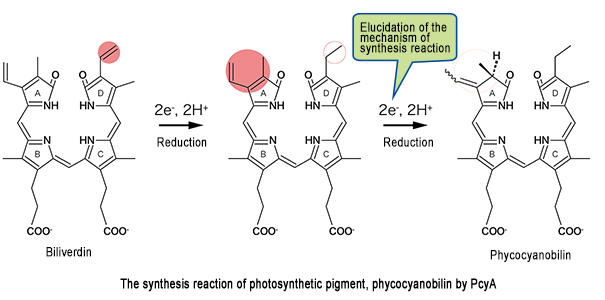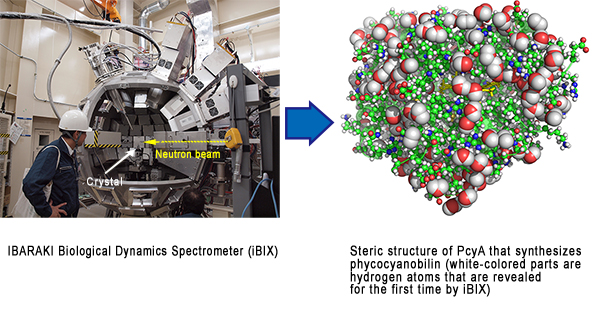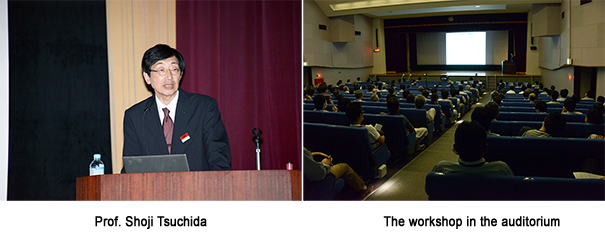| Ā° J-PARC News - May 2015 (Issue #121) |
| ĀúCeremony Held Commemorating Completion of the J-PARC Research Building (May 11) |
|---|
| On May 11, a ceremony commemorating completion of the J-PARC Research Building was held by the Japan Atomic Energy Agency (JAEA), High Energy Accelerator Research Organization (KEK), and J-PARC. The ceremony was attended by the Director of the Office for Quantum and Radiation Research, Science and Technology Policy Bureau, Ministry of Education, Culture, Sports, Science and Technology (MEXT), the Mayor of Tokai Village, and many other guests, as well as representatives of the various companies involved in the building's construction. The guests extended their congratulations, and some expressed their desire that the facility make safety the top priority in its operation and research. Other events at the ceremony included presentation of letters of thanks to those involved in the construction, unveiling of a commemorative signboard, and commemorative tree planting. |
|
| ĀúVisit by Princess Sirindhorn of the Kingdom of Thailand (April 23) |
| Her Royal Highness Princess Sirindhorn of the Kingdom of Thailand recently visited Japan to tour Japanese educational and research institutions, and on April 23 she visited J-PARC and the Ibaraki Neutron Medical Research Center in Tokai Village. At J-PARC's Materials and Life Science Experimental Facility (MLF), Deputy Director Masatoshi Futakawa provided an overview of the facility, and explained topics such as experiments using neutrons and muons. After that, the princess toured the Neutrino Experimental Facility, and at the Ibaraki Neutron Medical Research Center she observed a next-generation cancer therapy, Boron Neutron Capture Therapy (BNCT) and other treatment equipment. The princess has high expectations for stronger research ties with the Kingdom of Thailand in the future. |
| |
| Ā£to Page Top |
| |
|
| In neutron structure analysis using the Ibaraki Biological Crystal Diffractometer (BL03, iBIX) at the Materials and Life Science Experimental Facility (MLF), the research group led by Professor Masaki Unno of Ibaraki University elucidated, at the level of hydrogen atoms, the structure of the enzyme "PcyA" which synthesizes phycocyanobilin - a type of photosynthetic pigment. PcyA carries out the complex reaction of reducing separate locations on the pigment molecule in two stages. By visualizing hydrogen atoms in the enzyme structure, this research clarified how PcyA synthesizes phycocyanobilin by strictly controlling this two-stage reaction. In the future, these results are expected to have applications in artificial photosynthesis systems and photoresponsive sensors.
These results were achieved through joint research by Ibaraki University, Osaka University, the Japan Atomic Energy Agency (JAEA), Kurume University, Miyazaki University, Kurume National College of Technology, Maruwa Foods and Biosciences, Inc., and Ibaraki Prefecture. http://pubs.acs.org/doi/abs/10.1021%2Fjacs.5b00645 |
 
 * Click here to enlarge. * Click here to enlarge. |
| |
 
 * Click here to enlarge. * Click here to enlarge. |
| |
| Ā£to Page Top |
| |
|
| J-PARC is planning to build a Transmutation Experimental Facility (TEF) for R&D on volume reduction and mitigation of harmfulness of high-level radioactive waste by using an Accelerator-Driven System (ADS). In the ADS Target Test Facility (TEF-T) of the TEF, a liquid lead-bismuth eutectic (LBE) target will be irradiated with a high-power (250 kW) proton beam, and irradiation effects on structural materials will be studied. It is supposed that LBE is the promising candidate material as the ADS's proton beam spallation target and core coolant because it has good neutron yield and is inactive chemically in comparison with other coolant materials (e.g., water, sodium). On the other hand, LBE is corrosive, so it is necessary to control oxygen concentration in LBE adequately to protect structural materials from the corrosion. In order to control the oxygen concentration in LBE, it is required to develop an oxygen sensor to measure the oxygen concentration. |
| The oxygen sensors have previously been purchased through international cooperation with Europe and been used to measure the oxygen concentration in LBE. Last year, J-PARC tried to fabricate two-types of oxygen sensors (platinum type and bismuth type) with referring the European ones. As the result, it was confirmed that output voltage of the platinum type sensors was adequate in a wide temperature range. For the platinum type sensor, it is known that there is a possibility of LBE leakage if the sensor would fail. To prevent the LBE leakage, a special structure was installed to the sensor itself. It was confirmed by experiments that this special structure was useful to prevent the LBE leakage. This concept will be employed to measure the oxygen concentration of the LBE loop in TEF-T. |
| In the future, J-PARC will work in this field with collaboration with the JAEA's Nuclear Science and Engineering Center, universities, and other partners ? to carry out basic researches to increase the precision of sensor outputs and to reduce the sensorĀ@failure rate, and perform demonstration tests in LBE test loops. |
|
| At J-PARC, it was decided to hold this workshop every year around May 23, the date when the radioactive material leak incident at the Hadron Experimental Facility occurred. The aim is to review and further heighten the safety awareness of staff and other involved persons, and ensure that the lessons of the incident are not allowed to fade away. This year, the workshop was held on May 22. The invited speaker was Professor Shoji Tsuchida, who specializes in risk communication theory and social psychology at Kansai University. On the day of the workshop, the main venue was the auditorium of the Japan Atomic Energy Agency (JAEA), and there was a live TV link with other locations such as the KEK Tsukuba Campus. There were also talks by Naohito Saito, Director of the J-PARC Center, and by Tetsuro Ishii, Deputy Director of J-PARC Center. |
| |
 
 * Click here to enlarge. * Click here to enlarge. |
| Ā£to Page Top |
| |
|
| ĀúPeriodic Inspection of J-PARC (May 25-26) |
| In late May, periodic inspections were carried out by the Nuclear Safety Technology Center, a certified inspection organization of the Japanese government. On the 25th, dosimetry was conducted at the 50 GeV synchrotron (MR) and the Neutrino Experimental Facility, and on the 26th, ventilation/drainage equipment and signs were inspected at the linac facility and Hadron Experimental Facility. These periodic inspections are undergone once every five years, and the purpose of dosimetry is to check that radiation doses at the predetermined locations are at or below the prescribed value during accelerator operation. The inspections also checked whether ventilation/drainage equipment and signs are being used in the proper condition. |
|
| ĀúThe originally scheduled operation of the Materials and Life Science Experimental Facility (MLF) will be canceled in order to replace the neutron target vessel. |
|---|
| At the MLF, the target vessel is currently being replaced once a year, and this year replacement was scheduled for the summer maintenance period in July to September. However, defects in the vessel were confirmed at the end of April, and it was decided to carry out the replacement work about two months ahead of time. We would like to apologize to all of our users for this inconvenience. For details, please see the J-PARC home page. |
| ĀúNotice and Apology Regarding Cancellation of 2015B Call for Proposals for MLF |
|---|
| At the MLF, operations in the 2015A period had to be canceled due to the replacement of the target vessel. Therefore it was decided to shift the approved proposals which had been scheduled for 2015A to 2015B, and the 2015B call for proposals will be canceled for this reason. We would like to apologize once more to all of our users. |
| ĀúStatus of the Hadron Experimental Facility |
|---|
| The user operation of the Hadron Experimental Facility was resumed on April 24, and users conducted experiments with the maximum proton-beam power of 27 kW. At present, four secondary beamlines and experimental areas are in place, and data taking of the experiment in each beamline was performed smoothly. The next user operation is scheduled to start from June 4. |
|
©2015 J-PARC Center. All rights reserved.
|
|